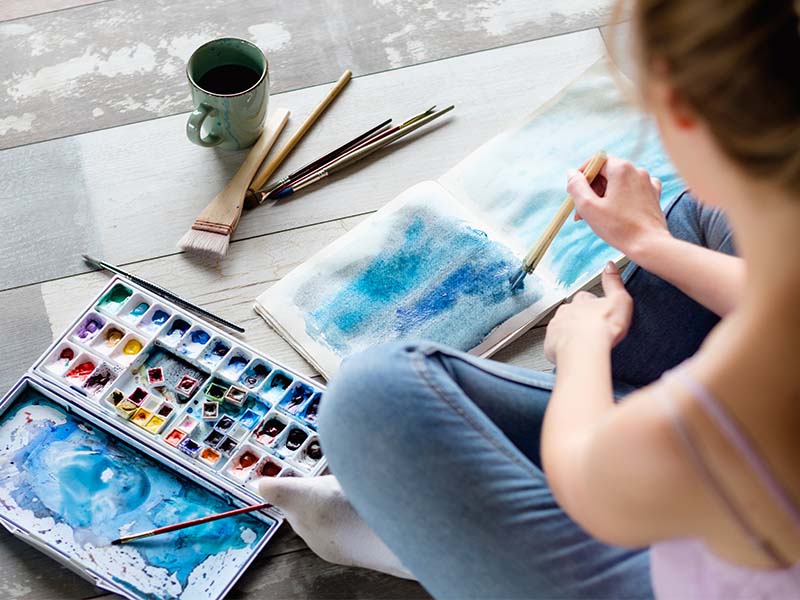

How Art Therapy Can Heal Trauma and Contribute to Holistic Well-Being
Artistic expression is a key part of humanity. Humans have been expressing themselves in creative ways since the beginning of time throughout every culture. Through cave painting, carving, pottery, weaving, and massive temples we have found ways to express ourselves through visual forms. Human expression is key to our growth, healing, and well-being. Recently art has been brought into the scientific world so we can understand the neurobiology of its healing potential.
Art is becoming a science that allows us to understand our minds, bodies and what it means to be human. We desire understanding and connection that is expressed through our creative spirit. When we step into the timeless space of art, we connect to not only our selves but to others and to realize what it means to be human.

What is art therapy?
Art therapy involves the creative combination of psychotherapy with self-expression and exploration. With the use of color, shapes, music, movement one is able to process and express thoughts and feelings that may otherwise be difficult to articulate. When we are able to express and articulate through art the issues that are haunting us, we reduce our anxiety and improve our physical, mental and emotional well-being. Through self-awareness and expression, we improve our self-esteem as we work through our underlying issues.
Who is an Art Therapist?
Art therapist are trained in both art and therapy. They are knowledgeable about human development, psychological theories, spirituality, multicultural and artistic traditions, clinical practice and the healing potential of art. Many art therapists have their master’s in psychology, or they have special art therapy training after their undergraduate degree.
Who can Benefit from Art Therapy?
Art therapy is available to all ages and diverse client populations. Art therapy can help a diverse number of life challenges including behavioral problems and addictions, psychological and medical issues, trauma, anxiety, depression or for those that are seeking personal insight and development. No artistic abilities or talents are needed to do art therapy and gain its benefits.

Neuroscience Behind Art Therapy and Healing
Art therapy has the ability to rebalance the brain functions after they have been compromised by trauma, attachment injuries, and other challenges. Art therapy promotes access and integration of both brain hemispheres. The right brain is accessed through spontaneous, relational and creative engagement accesses affective interpersonal states. The therapist then draws attention, communication, focus, and logical understanding throughout the session that engages the left brain. The imagery that is expressed is accessing both areas of the brain, emotional, sensory, and cognitively. This allows for greater integration of subcortical and cortical functions allowing for the inner experience to be consciously expressed through creativity. The balancing of the brain through verbal and non-verbal expression supports neural integration and promotes stress reduction.
The interpersonal self is able to emerge in the space between the nonverbal and verbal meaning of the experience. Throughout the art-making process, there is changes in the brain that strengthen healthy pathways resulting in neuroplasticity.
How Art Therapy Helps with Trauma PTSD
PTSD is a psychiatric disorder that can result after a traumatic event. The traumatic event can be war, car accidents, physical or sexual abuse, and neglect. Many individuals who experience trauma will not develop PTSD but for those that do the trauma experience remains stuck in the body and mind long after the incident is over. They feel unsafe in their lives and bodies as they respond to the undigested trauma memory causing anxiety, panic, re-experiencing the trauma, reactivity, numbness, and dissociation. This causes functional impairment in their life and the ability to form healthy relationships and connections.
Art therapy opens the door to healing after trauma. Art can allow people to regain the loss of emotional connection and attachment disruption after trauma. Art therapy creates a safe space that allows for opportunities of genuine creative expression with access to affective interpersonal states through self-representations. Art therapy gives space for individuals to work through the undigested memories of the trauma so they can be integrated properly into the past. Often individuals cannot articulate their trauma and art allows them to process it in a new way.
Art therapy gives people access to their strengths and builds grounding and coping skills through images rather than words. They can express their story, emotions, thoughts, and sensations through color, images, and drawing. Art allows a safe way for people to express their emotions, thoughts, and memories when words have failed them. Art allows one access to information, emotions, and experience that could not be accessed through talking alone but are pivotal to integration, healing, and growth.

Healing the Body
After trauma, many people feel disconnected and dissociated from their bodies. Art therapy allows them to reclaim this safety within themselves. Art therapy allows people to externalize what is occurring inside of them. As they put together the pieces of their trauma story their physical experience starts to change.
Just as art therapy bridges feelings and words it also can bridge back into feeling grounded and safe in one’s body. Art therapists are trained to use different art media to help individuals get more into their bodies. To heal the relationships that was threatened with the trauma. Art therapist helps individuals to sooth their overactive nervous system helping them self-regulate and find safety.
Art therapy allows for wellness, a harmonious connection between emotional, mental, physical and spiritual well-being. Art allows for this harmony inside of the body and brain allowing integration of the whole person which sets one up for flourishing. The integrated pieces of art therapy contribute to not only healing from trauma and other psychological and physical challenges but for optimal health and wellness.
-
- Kapitan, L. (2014). Introduction to the neurobiology of art therapy: Evidence based, complex, and influential. Art Therapy, 31(2), 50-51
- Kip, K. E., PhD., Hernandez, D. F., PsyD., Shuman, A., M.S.W., Witt, A., M.S., Diamond, D. M., PhD., Davis, S., Kip, R., Abhayakumar, A., Wittenber, T., Girling, S., Witt, S., & Rosenzweig, L., M.S. (2015). Comparison of accelerated resolution therapy (ART) for treatment of symptoms of PTSD and sexual trauma between civilian and military adults. Military Medicine, 180(9), 964-971.
- Schouten, K. A., van Hooren, S., Knipscheer, J. W., Kleber, R. J., & Hutschemaekers, G. J. M. (2019). Trauma-focused art therapy in the treatment of posttraumatic stress disorder: A pilot study. Journal of Trauma & Dissociation, 20(1), 114-130.


